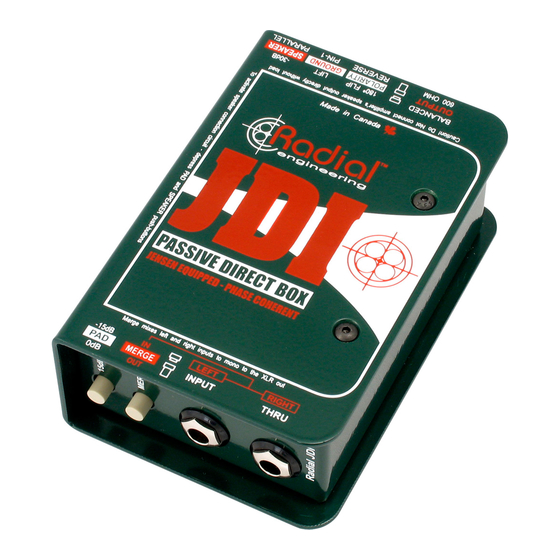
Table of Contents
Advertisement
Quick Links
Advertisement
Table of Contents

Summary of Contents for Radial Engineering JDI Mk3
- Page 1 DUPLEX User Guide Radial Engineering 1638 Kebet Way, Port Coquitlam BC V3C 5W9 tel: 604-942-1001 • fax: 604-942-1010 email: info@radialeng.com • web: www.radialeng.com Radial Engineering is a division of C•TEC (JP CableTek Electronics Ltd.)
-
Page 2: Table Of Contents
Radial Engineering 1638 Kebet Way, Port Coquitlam BC V3C 5W9 tel: 604-942-1001 • fax: 604-942-1010 email: info@radialeng.com • web: www.radialeng.com C•TEC Radial Engineering Ltd. is a division of (JP CableTek Electronics Ltd.) Features and specifications are subject to change without notice. -
Page 3: Introduction
Part 1 - Introduction Congratulations on your purchase of the world’s finest direct box! The Radial JDI Mk3 is the latest version of the highly acclaimed JDI and is without a doubt the finest passive direct box available today. The JDI is very unique in that it does not color or alter the sound in any way. -
Page 4: Jdi Feature Set
filter to emulate a 12" driver. Note: Only use in parallel with a speaker cabinet or load box. (7) Full bottom no-slip pad - reduces slipping in use and provides mechanical and electrical isolation. Radial Engineering JDI User Guide... -
Page 5: Jdi Quick Start
This is especially true with phantom powered equipment. The Radial JDI Mk3 is a passive direct box and as such does not require any external power such as phantom or batteries to make it work. Just plug-in and play! To start, make sure all switches are in the ‘out’... -
Page 6: Direct Box Basics
Balanced signals inherently cancel noise and due to their lower impedance, can travel much further without degradation. Balanced signals are the norm in professional recording, broadcast and live sound. By properly matching the impedance you will enjoy better sound, less noise and an extended frequency response. Radial Engineering JDI User Guide... - Page 7 True to the Music Getting to know your Radial JDI Mk3 As a rule, all direct boxes follow the same basic procedures when connecting them to a sound system. The instrument plugs into the INPUT, the musicians’ instrument amplifier connects to the THRU and the mixer or recorder is connected to the XLR ‘OUTPUT’.
- Page 8 Jensen transformer we use. Equipment is Equipment is connected connected through audio through A/C cable. ground. The Problem: The Cure: Ground loop between Equipment isolated with conneced equipment. an audio transformer. Radial Engineering JDI User Guide...
-
Page 9: Features And Functions
To ‘merge’ simply connect two instruments with similar output levels into the IN and THRU jacks, depress the MERGE switch to the ON position and you are set to go. The internal resistive mixer is set up to do this without introducing any problems such as phase cancellation. Radial Engineering JDI User Guide... - Page 10 Often these two devices will be connected to different AC outlets or may have very different ground reference potentials. When connected together, these can sometimes cause 60-cycle hum or a loud system buzz. This noise is often referred to as a ground loop. Radial Engineering JDI User Guide...
- Page 11 ‘dry’ signal directly from the instrument. Examples would be capturing the EQ and compression settings from a bass amplifier, recording the distorted sound of a guitar amplifier, or maybe combining the sound of a mic’d amplifier with a direct feed off the speaker. Radial Engineering JDI User Guide...
- Page 12 Radial DI, splitter or isolator products into a high-density 2-RU space. Each unit can be front or rear mounted allowing the system designer to have the XLRs on the front or rear of the rack, depending on the application. Radial Engineering JDI User Guide...
-
Page 13: Other Cool Uses For Your Jdi
This is a good trick to use when recording the sound from your amplifier at some distance while you play in the control room and listen through studio monitors or headphones. Radial Engineering JDI User Guide... -
Page 14: Frequently Asked Questions
Splitting the signal to the instrument amplifier and the mixer added a second load. This of course would reduce the level going to the instrument amplifier, thinning and colouring the sound. Radial Engineering JDI User Guide... - Page 15 Reversing the phase has to do with the time domain. When a frequency is delayed by 180º and played with the original, the out of phase signals cancel each other out. Reversing the polarity of one of two speakers has the same audible effect. Radial Engineering JDI User Guide...
- Page 16 A: No. The Radial JDI Duplex is designed as a stand-alone device. If you are looking for a rackmount solution that takes up even less space than the J-Rak, the 1-RU Radial JD6 may be your solution with 6 JDI channels in 1 RU space. Radial Engineering JDI User Guide...
-
Page 17: Block Diagram And Specifications
True to the Music Part 7 – Block diagram and specifications JDI Block Diagram JDI Mk3 (and JDI Duplex) Specifications Type Passive Jensen Transformer equipped Input impedance Unbalanced 140k-Ohms typical Output impedance Balanced 150 Ohms typical Frequency response 10Hz to 40kHz Linear performance <... -
Page 18: Warranty
RADIAL ENGINEERING - 3 YEAR LIMITED WARRANTY RADIAL ENGINEERING (a division of J.P Cabletek Electronics Ltd.) warrants this product to be free from defects in material and workmanship to the original owner and will remedy any such defects free of charge according to the terms of this warranty.





Need help?
Do you have a question about the JDI Mk3 and is the answer not in the manual?
Questions and answers